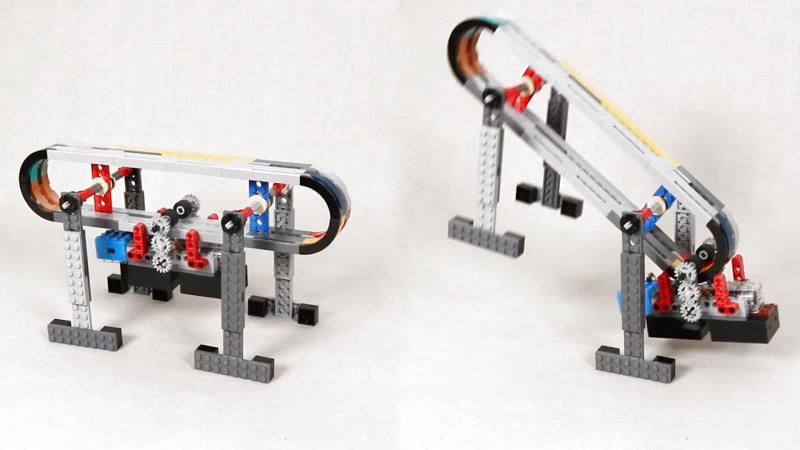Lego Technic is a wonderful thing, making it easy to toy around with all manner of complicated mechanical assemblies without needing to do any difficult fabrication. [touthomme] recently posted one such creation to Reddit – a walker design that is rather unconventional.
The design dispenses with individually-actuated legs entirely. Instead, the two front legs are joined by an axle which pivots the legs about the body, which is shaped like an oval track. The rear legs are the same. A motorized carriage then travels along the oval track. When the weighted carriage reaches the front of the oval track, it forces the body to tip forwards, pivoting around the front legs and flipping the entire body over, swinging the rear legs forwards to become the front. The cycle then repeats again.
The flipping design, inspired by a toy, is something you wouldn’t expect to see in nature, as few to no animals have evolved mechanisms capable of continual rotation like this. It’s also unlikely to be a particularly efficient way of getting around, and the design would certainly struggle to climb stairs.
Some may claim the method of locomotion is useless, but we don’t like to limit our imaginations in that way. If you can think of a situation in which this walker design would be ideal, let us know in the comments. Alternatively, consider other walking designs for your own builds. Video after the break.
Still some work to do, but I was so excited it actually worked I had to share. from lego
[Thanks to Pedropolis for the tip!]















I love it, reminds me of something, possibly some window descending toys I had as a kid.
Attack Track?
https://headhunterstore.weebly.com/uploads/1/0/4/7/10471793/s649008395989639175_p1990_i4_w1000.jpeg
also the other 80’s he-man toy that did the same thing sideways, “Dragon Walker” https://nothingbutnostalgia.com/wp-content/uploads/2015/12/Dragon-Walker.jpg
Reminds me of a train toy that went around tracks and push curves around to connect tracks to keep going.
I wouldn’t be surprised if this is actually more effective in climbing stairs than many other lego walker designs. The moving center of gravity should definitely help, as long as the motor is strong enough to pull the carriage up the rail.
And also the heigh of the steps – it reaches a lot higher than a typical linkage-walker or frame-walker.
Agreed – Having tried to build stair climbing Lego before I can say with certainty this is a sound design for the limitations of Lego, as it does the one thing any more complex gait does not – keeps it light enough while having the step height – might well need to make the body a bit longer and thus the weight heavier to step far enough but still looks like a much better concept for the limitations of Lego walking than most. Also the Lego tyre are usually really quite grippy, and the longer you make the body the shallower the incline – yes the weight will need to get heavier but a good balance looks like it would be quite doable to me.
That said I’ve not played with the pneumatic (I never had enough to do much as a child and haven’t had the chance to really play around with the small collection I’ve built up since), or linear actuator parts (dates me a little, but they didn’t exist as off the shelf parts when I seemingly had all the time and space in the world to play with Lego). Nor have I really tried any of the newer motors enough to know if they have the torque to work (at a practical speed anyway) but with the 9V stuff it was always a struggle to get the gear ratio high or mass low enough to really walk, let alone at any real pace while actually picking up the feet. Did have a brief play with the NXT motors and hated them hugely, the performance seemed alright but actually building them into anything with their giant size and relatively few attachment points was tricky.
(Of course if you have all the time in the world for each step it isn’t hard at all the worm gears give you great reduction in small space and weight, and with all the time in the world for each step the whole thing can be built much heavier to overcome the natural flex of long thing Lego structures…)
if the main body is too heavy and the carriage isnt heavy enough,the body and carriage could struggle to move
This reminds me of an old christmas toy that I had in the 80s, a He-man Dragon walker – https://www.youtube.com/watch?v=BNyKb87iU5I
Wrong link.
Moving draw-bridge.
Steps across a stream.
Who is the first to scale this thing up for burning man!
+500 Quatloo
He should call it a Walking Trebuchet.
whats the name of the origin the movement system